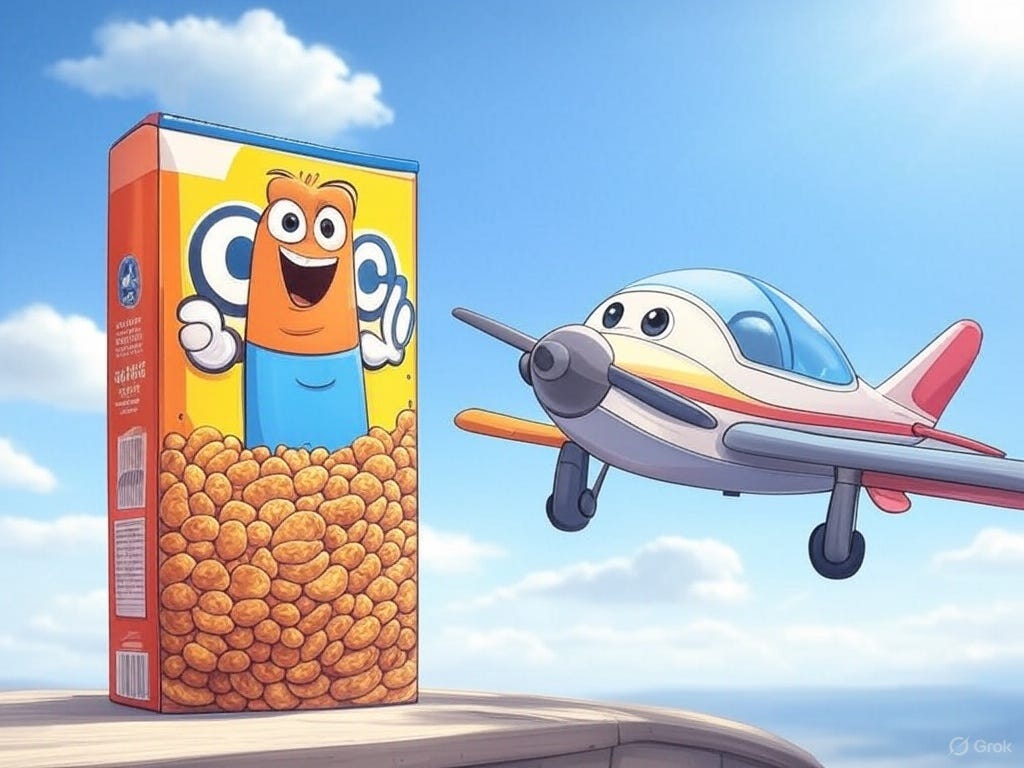The Foundation Model Trap
Why AI Model Companies Are More Like Airlines than Like Cereal Companies
Harvey Sawikin recently wrote a great article analyzing the AI industry through a very Munger-like lens: will AI turn out more like the cereal industry (where there are many competitors with very healthy profit margins) or more like the airline industry (where competition compresses profit margins to near 0).
This idea has major implications for the major AI labs training foundation models today, such as OpenAI, Anthropic, and xAI. In this article I'll attempt to flesh out my understanding of this cereal vs. airline distinction and discuss why the airline scenario is more likely for the foundation model providers.
Before we dive in, you can find Harvey’s article below. I highly recommend giving it a read before continuing here.
Okay, so let’s start with differentiating why cereals allow for competition with healthy profit margins, whereas airlines are a rough business for all involved.
Cereals have different flavors, so consumer preferences for a certain flavor can cause some degree of demand inelasticity. From a firm perspective, rather than chasing the flavor and profit margins of another firm's cereal, the more profitable long-term strategy is to specialize in a different flavor and reap your own healthy profit margins.
By contrast, the main service that airlines provide is transporting you from Point A to Point B. There isn't really an "experience" to speak of that differentiates airlines from one another (particularly for non-business class flyers), so the calculus for a consumer then comes down to only two factors: speed and cost. Speed can be achieved through two means: faster planes (which hasn't happened in decades) and more direct flights. Airlines are incentivized to provide direct flights between major cities/transit hubs because, if they did not, then any travelers going between major hubs (say, NYC and London) would choose the other airlines which did have those direct flights. Thus, we can assume that most major airlines will have direct flights between most major transit hubs/cities within a certian distance of each other. Hence, for any two airlines that have a direct flight between a fixed pair of cities, the only way to compete is on price, since this will be the only criterion differentiating the airlines for consumers. Thus, a small difference in price will lead to nearly all consumers choosing the cheaper options. This inherently must drive down profit margins as airlines seek to charge the lowest possible price while still maintaining profitability.
Translating this argument to AI, we see two potential paths forward:
Cereal Mode: We know that the data input to a model during its training process basically determines its behavior on the other end - what it acts like, what tasks it's good at, etc. Access to different types of data may thus give rise to different "flavors" of AI models, providing varying skill profiles and personalities. In this scenario, we could imagine that OpenAI provides the best chat experience (due to its large dataset of user chats), while Grok might provide the best news aggregation and summarization (due to its up-to-the-second Twitter data). This may provide enough distinction to allow each AI company to charge healthy profits margins on their respective foundation models.
Airline Mode: In this case, maybe the data on the margins provided by chat interactions, Twitter, etc. doesn't move the needle much in terms of model behavior and capabilities. Perhaps the web-scale pretraining data drowns out the idosyncracies across each AI lab's datasets, leaving each lab's state-of-the-art AI models performing roughly identically. In this case, the only way to compete would be on the API pricing, with consumers rapidly moving to the cheapest option available that can perform the given task.
Based on trends of the last few months, I think Airline Mode is looking more and more likely. The Chatbot Arena leaderboard shows that all of the leading models from the main labs perform roughly similarly to each other (Grok 3 and GPT-4.5 are even currently within 1 Elo point of each other as of this writing!). And DeepSeek was able to reproduce OpenAI o1 in the span of a couple months (R1's Elo is actually 11 points higher than o1's). We're seeing more convergence between models over the last couple of years, not less.
Given that, unless a lab gets to AGI and the idea of recursive self-improvement leading to a permanent advantage turns out to be true, I don't see how foundation model training can provide durable, healthy profit margins without a significant change in business model for these companies.




I think precisely because all AIs are relatively the same, it's more important to venture to the cereal model. AI is NOT airlines, because the nature of the work is so much more open-ended.
Airlines' purposes are to get you from point A to point B, and everything else is just pedantic. If you had a good time on the flight is unimportant if you can save a couple hundred bucks, right?
But Generative AI is so open-ended that differentiation is almost inherent to the model. Sure, models right now are blending together in terms of proficiency. But that's why it's better, business-wise, to be hyper-differentiated.
If you can be a model that is 1% better at investment trading than the other models, but 2% worse at writing screenplays, you will not be the "frontier" model, but you will be deployed in investment firms.
Of course, this assumes AI models can be created that are really good at one thing while sacrificing performance in other areas. I think there's some research showing that improving a generalist is better than improving a specialist in terms of actual model performance. So while going for cereal might be better for business, it could be impossible technically, but nonetheless something to look at.